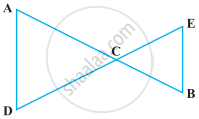Advertisements
Advertisements
प्रश्न
Solve the following question using appropriate Euclid’s axiom:
In the following figure, we have AC = DC, CB = CE. Show that AB = DE.

उत्तर
Given, AC = DC ...(i)
And C6 = CE ...(ii)
According to Euclid’s axiom, if equals are added to equals, then wholes are also equal.
So, on adding equation (i) and (ii), we get
AC + CB = DC + CE
⇒ AB = DE
APPEARS IN
संबंधित प्रश्न
Consider two ‘postulates’ given below:-
- Given any two distinct points A and B, there exists a third point C which is in between A and B.
- There exist at least three points that are not on the same line.
Do these postulates contain any undefined terms? Are these postulates consistent? Do they follow from Euclid’s postulates? Explain.
If a point C lies between two points A and B such that AC = BC, then prove that AC = `1/2` AB. Explain by drawing the figure.
In the following figure, if AC = BD, then prove that AB = CD.

In how many points a line, not in a plane, can intersect the plane?
Greek’s emphasised on ______.
Euclid belongs to the country ______.
Pythagoras was a student of ______.
Euclid stated that all right angles are equal to each other in the form of ______.
The boundaries of the solids are curves.
The following statement is true or false? Give reason for your answer.
A terminated line can be produced indefinitely on both the sides.
